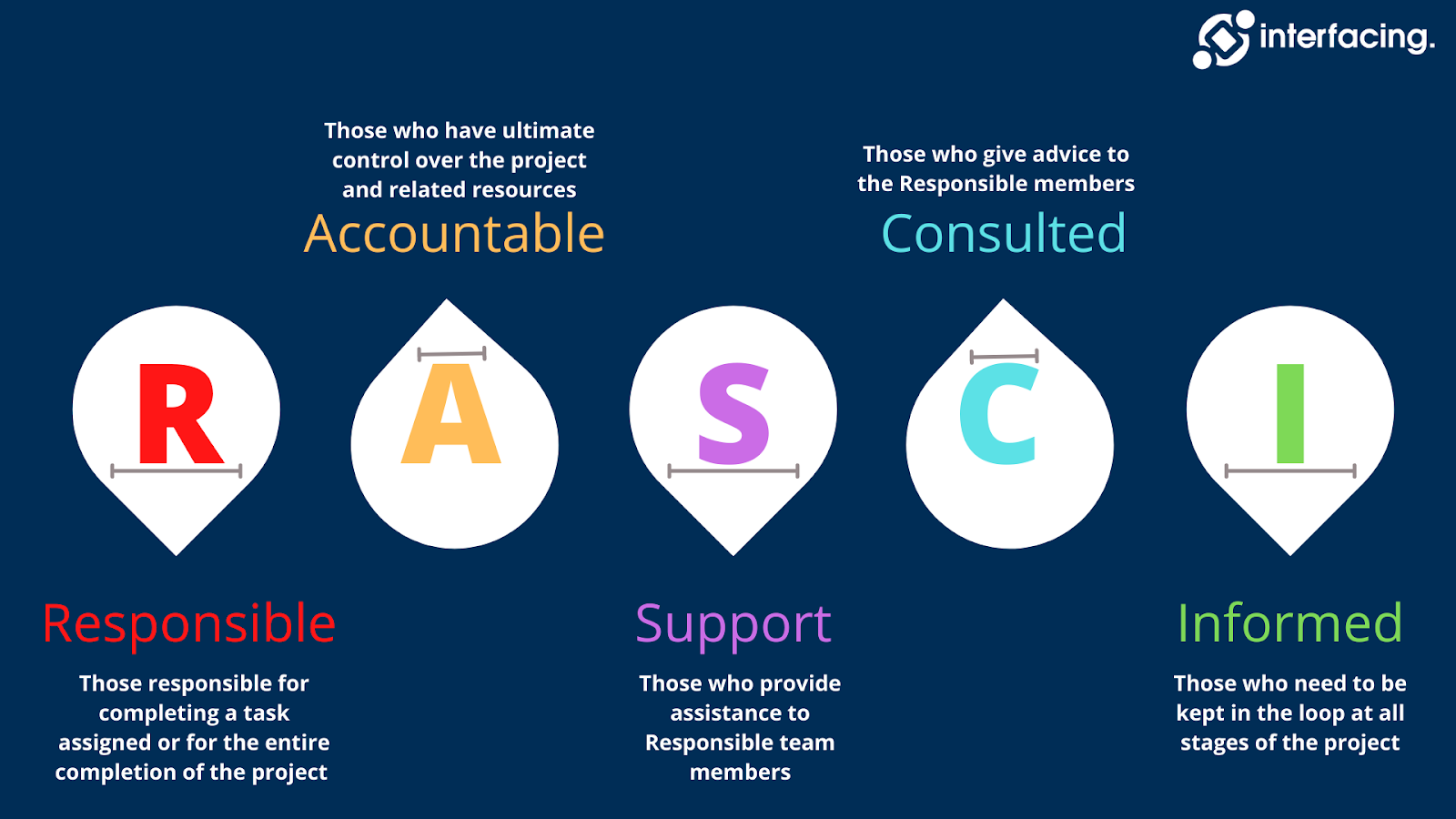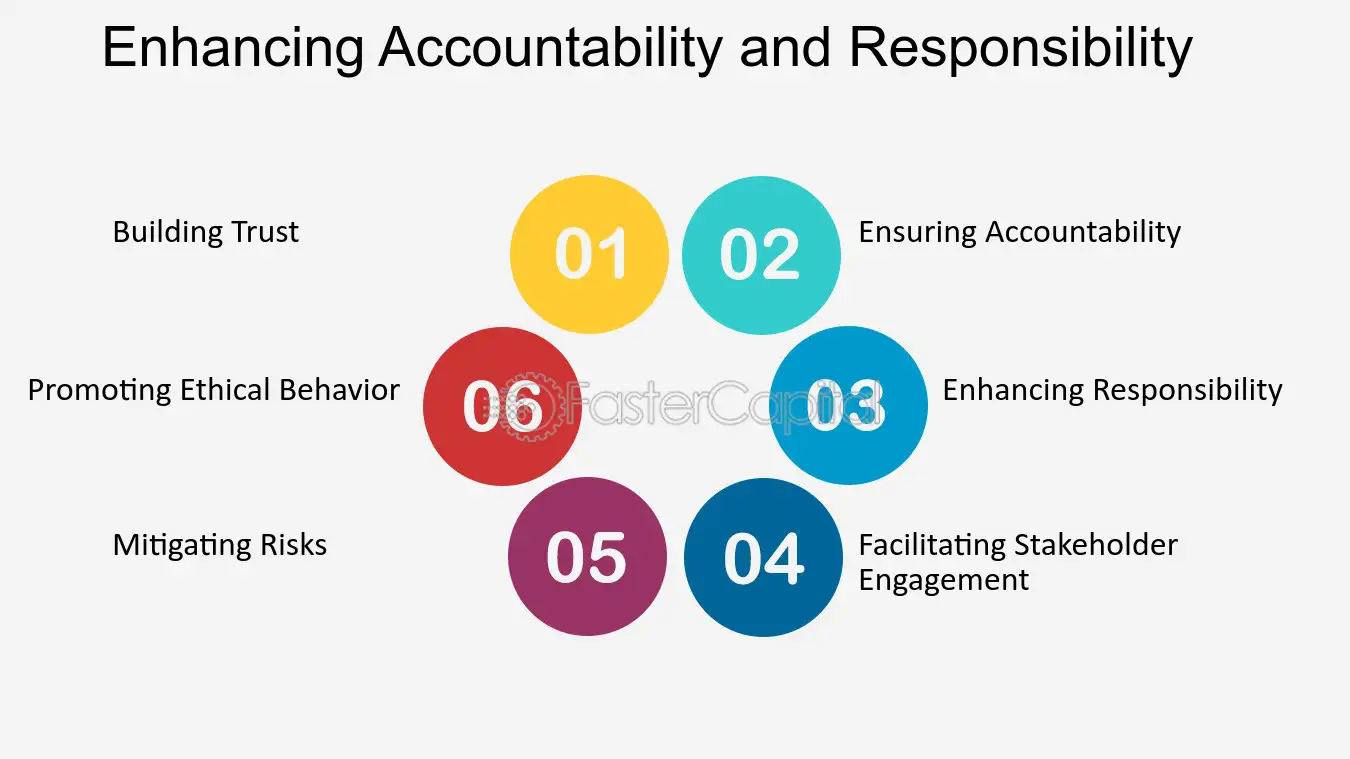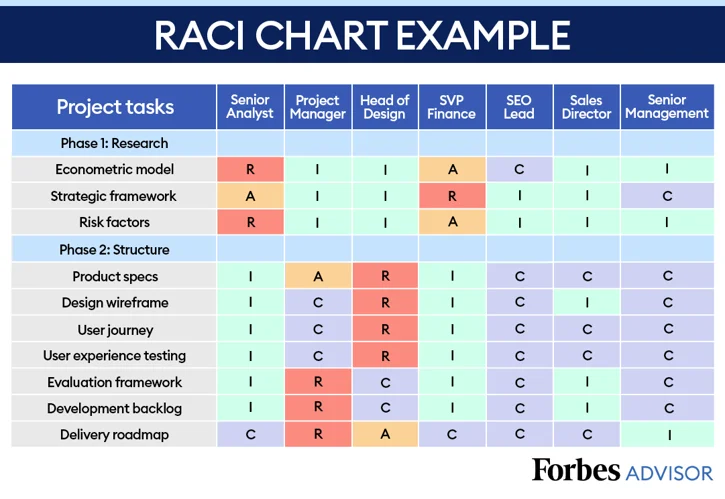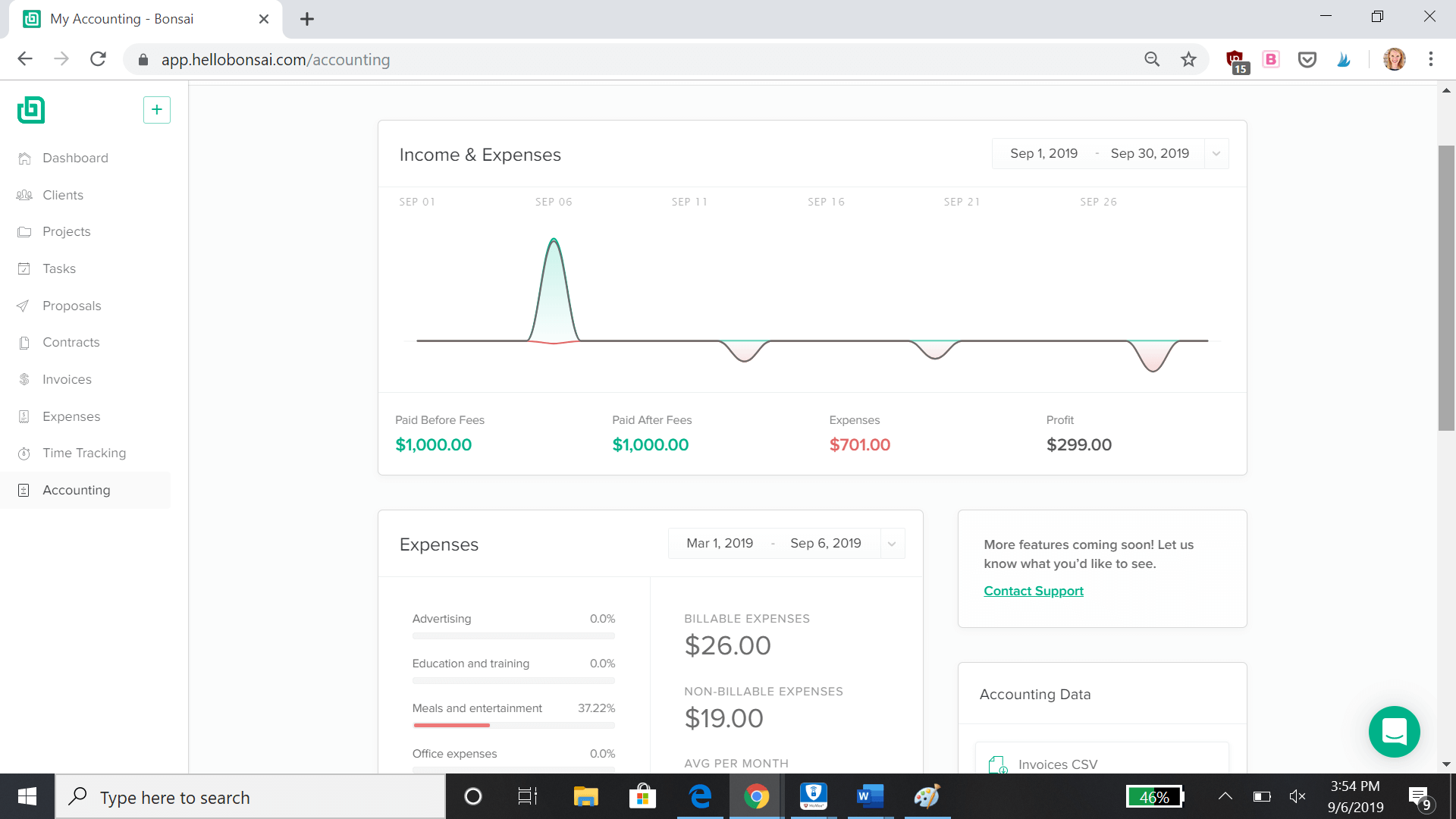RACI chart represents Responsible, Accountable, Supportive, Consulted, and Informed order—a version of the RACI matrix. It's a useful tool for managing a project to identify roles and responsibilities throughout the project life cycle and ensure optimal task allocation to team members. These charts contribute significantly to projects being delivered correctly to their stakeholders, which improves project outcomes. The main difference between RACI and RASCI is the additional 'S,' which represents Support. It highlights those who provide support or resources in the project hierarchy, enhancing the distinction in responsibility. A correctly used RASCI matrix can significantly enhance project management efforts.
What is a rasci chart?

Getting to know RASCI charts, also known as RACI charts or RASCI matrices, is important in project management. At a glance, they show the roles and responsibilities of team members and clearly indicate what project steps are involved. Specifically, the RASCI matrix identifies the people who are Responsible, Accountable, Supportive, Consulted, or Informed for each project task. The project hierarchy created with this chart makes task distribution efficient and helps set clear expectations for project outcomes. This method encourages transparency for stakeholders and clarifies everyone's responsibility in the project.
What is a RASCI chart?
A RASCI chart, also called a RASCI matrix, is a useful project management tool. This chart clearly indicates roles and responsibilities at various stages of a project life cycle. The acronym stands for Responsible (person taking responsibility), Accountable (delivering the project output), Supportive (providing support with the task), Consulted (whose input is required), and Informed (who need to be kept aware of the task). The purpose of the RASCI chart is to ensure effective task distribution among team members, minimizing confusion and increasing work performance. It provides an overall map of the project hierarchy and serves as a guideline for communication among stakeholders throughout the project.
Why use rasci charts in project management?
RACI charts or RASCI matrices play a fundamental role in project management. They ensure effective task distribution among team members through clear definitions of Responsible, Accountable, Supportive, Consulted, and Informed roles throughout the project life cycle. These charts help project managers establish a clear project hierarchy and effectively manage stakeholder expectations. With such charts, all stakeholders are well aware of their duties and expectations, enabling a smooth workflow that leads to positive project outcomes.
Components of a RASCI chart
A RASCI chart, an essential project management tool, refers to a tool that deals with the roles and responsibilities of the project team members throughout the project Life-cycle. It ensures effective task allocation and a clear project hierarchy that describes who is responsible, accountable, supportive, consulted, and informed (RASCI) for every project task.
- Responsible: Person who does the work
- Accountable: Person who has decision-making responsibility and ownership
- Supportive: Team members who help out in doing the work
- Consulted: Persons whose views are Asked of And who has inputted
- Informed: Persons who need to Be kept up-to-date On how things are going Or how things turn out
In this way, an RASCI matrix lays out a stakeholder's commitment To inform each one towards The role one plays in bringing successful project results.
How to define roles in rasci charts
In project management, the RASCI matrix is a tool that clearly defines and assigns roles and responsibilities among team members during the project Life-cycle. The model helps optimize task distribution and the project hierarchy, enhancing overall project outcomes.
The RASCI acronym stands for:
- Responsible
- Accountable
- Supportive
- Consulted
- Informed
- Responsible: team members who complete the project tasks.
- Accountable: stakeholder or manager who verifies and approves task completion.
- Supportive: individuals who assist by performing secondary tasks.
- Consulted: subject matter experts who provide necessary input or advice.
- Informed: those who need to be aware of project decisions and progress.
How to define tasks in rasci charts
Clear roles and responsibilities are pivotal factors that need to be defined at the very start of project management. This clarity helps manage the many project tasks during implementation. The RASCI matrix is a tool for assigning tasks and defining authority in a project. It stands for Responsible, Accountable, Supportive, Consulted, and Informed—helping to delineate the various duties each project team member has relative to specific tasks. This ensures every stakeholder understands their role, the project life cycle, and how to contribute best to the desired outcomes. Besides defining communication limits within the team, the RACI matrix fosters openness and understanding throughout project management.
How to create a rasci chart

In project management, understanding Roles and responsibilities is crucial. Creating a RASCI chart simplifies this by providing a clear task distribution. The RASCI matrix is a great tool To delegate Tasks among team members and Define Their level of involvement, ultimately improving project outcomes.
The RASCI model stands for Responsible, Accountable, Supportive, Consulted, and Informed. Each role is vital in the project life cycle. The chart reveals project hierarchy clearly, making it a valuable tool for stakeholders who want to understand the structure and flow of project tasks.
Steps to build a rasci chart
Building a RASCI chart starts by identifying all the project tasks needed for successful outcomes. These might include activities across the project life cycle, from initiation through closure. The task distribution needs to be mapped properly in the RASCI matrix to avoid confusion among team members.
Next, clearly define roles and responsibilities. This involves determining who is Responsible, Accountable, Supportive, Consulted, and Informed (RASCI) for every task. Ensure each role is assigned to a stakeholder to create a precise project hierarchy.
Lastly, communicate the finalized RASCI chart to all stakeholders, ensuring they understand their responsibilities and the expectations of others within the project management team. This is key for successful task execution and project delivery.
Best practices to create effective rasci charts
In project management, a correct and focused approach to creating a RASCI chart helps define roles and responsibilities throughout the project life-cycle. Organize all project tasks according to a suitable project hierarchy, which allows better task distribution. Ensure every stakeholder, from team members to higher management, falls under the RASCI matrix designations:
- Responsible
- Accountable
- Supportive
- Consulted
- Informed
Revisit your RASCI chart periodically to ensure it continues to align with project outcomes and evolving team dynamics.
Benefits of rasci charts
Using RASCI charts in project management offers several benefits. These charts provide clarity over roles and responsibilities within project tasks, ensuring accurate task distribution and creating an organized project hierarchy. The RASCI matrix, an acronym derived from:
- Responsible
- Accountable
- Supportive
- Consulted
- Informed
This matrix encourages effective communication among stakeholders, thereby enhancing project outcomes.
Throughout the project life-cycle, RASCI charts mitigate confusion among team members, eliminate duplication of tasks, and ensure nothing slips through the cracks. Such visualization tools ultimately ensure smoother operation and successful project completion.
How rasci charts improve communication and collaboration
Project management heavily relies on effective communication and collaboration among team members. Understanding roles and responsibilities using tools like the RASCI matrix eliminates ambiguity and improves task distribution. It defines who is responsible, accountable, supportive, consulted, and informed for each project task.
Being clear on the project hierarchy helps with the flow of information and strengthens stakeholder communication, crucial in all phases of the project life-cycle. Regular communication on project outcomes keeps everyone on the same page and fosters a healthy collaboration environment.
How rasci charts enhance accountability and responsibility

Enhancing accountability and responsibility within project management relies on defining roles and responsibilities. This involves clearly distributing project tasks among team members and outlining the project hierarchy through tools like the RASCI matrix.
This matrix enforces being responsible, accountable, supportive, consulted, and informed throughout the project life-cycle, providing clear leadership and direction for stakeholder interests.
By implementing such clarity, team members are more likely to commit fully to their roles. This increases the potential for successful project outcomes.
How rasci charts streamline the decision-making process
Streamlining the decision-making process is vital to project management, particularly with task distribution and defining roles and responsibilities. One tool to facilitate this is the RASCI matrix, which delineates project hierarchy and the different roles of team members:
- Responsible
- Accountable
- Supportive
- Consulted
- Informed
This matrix assists throughout the project life-cycle in keeping all stakeholders aware of project tasks and their roles in achieving project outcomes.
Variations of rasci
Understanding the basic rasci model
The basic RASCI model clarifies roles and responsibilities by assigning five key categories: Responsible, Accountable, Supportive, Consulted, and Informed. Each task or decision in a project is matched with one or more of these roles to avoid confusion and overlap. For example, a freelancer managing a website redesign might be responsible for design tasks, while the client is accountable for final approvals.
This model helps small business owners and freelancers clearly define who does what, reducing delays and misunderstandings. Using tools like Trello or Asana, you can assign RASCI roles directly to tasks, ensuring everyone knows their part. This clarity is especially important in 2024, as remote work and cross-functional teams grow more common.
To implement the basic RASCI model, start by listing all your project activities, then assign the five roles accordingly. This foundational step sets the stage for exploring other RASCI variations that might better fit your project's complexity or communication style.
Common rasci variations and their uses
Several variations of RASCI exist to tailor responsibility mapping to specific project needs. One popular variation is RACI, which omits the Supportive role and focuses only on Responsible, Accountable, Consulted, and Informed. This simpler version suits smaller teams or projects with fewer support tasks.
Another variation is RAS, which includes Responsible, Accountable, and Supportive roles but leaves out Consulted and Informed. This can be useful in fast-paced environments where communication is streamlined, such as freelance graphic design projects where the client is directly involved.
Additionally, some teams use RASIC, where the Consulted and Informed roles are swapped to emphasize who needs to be consulted before action and who should be informed afterward. Understanding these variations allows freelancers and small business owners to choose the best fit for their workflow and client communication.
How to choose the right rasci variation for your project
Selecting the right RASCI variation depends on your project's size, complexity, and communication needs. For example, if your project involves multiple stakeholders with distinct support roles, the full RASCI model is ideal. In contrast, a solo freelancer working with a single client might prefer the simpler RACI model to reduce overhead.
Consider your communication channels as well. If you use project management software like Monday.com, ClickUp, or Asana, you can customize role assignments easily, making it practical to adopt more complex variations. For projects with tight deadlines, reducing roles to only Responsible and Accountable can speed decision-making.
To decide, map out your project tasks and stakeholders, then test a variation by assigning roles and observing how well it clarifies responsibilities. Adjust as needed to improve workflow and avoid bottlenecks. This approach ensures your RASCI model supports your project's success in 2024 and beyond.
Vertical and horizontal analysis of RASCI charts
Understanding vertical analysis in RASCI charts
Vertical analysis in RASCI charts focuses on examining the roles assigned to each task or deliverable. This means reviewing each column of the chart to see which individuals or teams are Responsible, Accountable, Supporting, Consulted, or Informed for specific activities. By doing this, you can quickly identify if any person or role is overloaded or underutilized across multiple tasks.
For example, if a project manager is marked as Accountable for five different tasks in a small project, vertical analysis highlights this potential bottleneck. Using tools like Microsoft Excel or Google Sheets, you can filter or sort the RASCI chart columns to count the frequency of each role assignment. This helps ensure balanced workload distribution and prevents delays caused by overburdening key team members.
To apply vertical analysis effectively, schedule regular reviews of your RASCI chart during project planning and execution phases. This proactive approach allows you to reassign roles as needed, keeping your team agile and focused. Freelancers managing multiple clients can use vertical analysis to avoid conflicts and maintain clear responsibilities.
Applying horizontal analysis to improve task clarity
Horizontal analysis involves looking across each row of the RASCI chart to understand the role distribution for a single task or deliverable. This helps clarify who is involved and in what capacity, ensuring no critical role is missing or duplicated. It also highlights if too many people are assigned to consult or inform, which can slow decision-making.
For instance, a marketing campaign task might have one person Responsible, one Accountable, a few Supporters, and several Consulted parties. Horizontal analysis helps verify that the Consulted group is not so large that it causes delays or confusion. Tools like project management software such as Asana or Monday.com allow you to visualize these role assignments clearly, making it easier to adjust as needed.
To implement horizontal analysis, review each task row during team meetings or planning sessions. Confirm that everyone understands their role and that the task has clear ownership. This approach reduces overlap and ensures smoother workflows, especially for small businesses juggling multiple projects simultaneously.
Combining vertical and horizontal analysis for balanced project management
Using both vertical and horizontal analysis together provides a comprehensive view of your RASCI chart. Vertical analysis ensures no individual is overwhelmed, while horizontal analysis guarantees each task has clear and appropriate role assignments. This dual approach helps freelancers and small business owners maintain efficient communication and accountability.
For example, after conducting vertical analysis to identify over-assigned roles, you can use horizontal analysis to redistribute responsibilities within specific tasks. This might mean shifting a Support role to Consulted or Informed to balance workload without losing essential input. Many project management platforms now support customizable RASCI templates, making it easier to perform these analyses in real time.
To maximize the benefits, integrate these analyses into your project kickoff and regular status updates. This habit keeps your team aligned and projects on track, reducing risks of missed deadlines or unclear responsibilities. Start by reviewing your current RASCI chart this week and adjust roles based on your findings to improve project outcomes.
Examples of rasci charts in real-world scenarios
Corporations use RASCI charts in project management to delineate roles and responsibilities among team members. For instance, a software development project may use a RASCI matrix to oversee task distribution. Developers, quality assurance teams, and project managers are responsible for core project tasks, while steering committees are accountable for high-level project outcomes.
In a construction project life-cycle, a RASCI chart might identify various stakeholder roles, such as architects being consulted on design elements, whilst contractors are supportive in implementing them. Supervisors could be identified as responsible for daily site activities, with site managers kept informed of progress.
NGOs often use RASCI charts to map out project hierarchy in community development projects, ensuring every task has a responsible party, and stakeholders are informed of their involvement.
How to use rasci charts in marketing agencies

In marketing agencies, utilizing RASCI charts can revolutionize project management by clearly defining roles and responsibilities. The RASCI matrix is used to distinguish who is:
- Responsible
- Accountable
- Supportive
- Consulted
- Informed
for each project task. This aids in task distribution, settles confusion regarding project hierarchy, and enhances collaboration among team members throughout the project life-cycle.
Often, a stakeholder takes the accountable role, ensuring distinct project outcomes align with agency strategy. The result of proper RASCI implementation is an effective, efficient marketing agency with well-established, transparent responsibilities for all project tasks, and a well-understood path to project success.
How to apply rasci charts in IT project management
In IT project management, the RASCI matrix plays a crucial role in defining roles and responsibilities, facilitating task distribution, and establishing the project hierarchy. The acronym stands for:
- Responsible
- Accountable
- Supportive
- Consulted
- Informed
It explicitly defines the part each stakeholder plays throughout the project life-cycle.
The RASCI charts ensure that team members clearly understand their duties and the expectations surrounding project tasks, thus enhancing the Efficiency of the team And increasing the likelihood of successful project outcomes.
Software tools to create rasci charts
There are many software tools that help identify roles and responsibilities within project management, especially for creating RASCI charts. These tools outline who is:
- Responsible
- Accountable
- Supportive
- Consulted
- Informed
for each project assignment. This clarifies the project hierarchy and task distribution. Team members gain a clear understanding of project outcomes and their explicit roles. Overall, using software tools to create the RASCI matrix streamlines project management.
Microsoft excel and Google sheets
Microsoft Excel and Google Sheets are effective for project management by assigning tasks to team members. Both platforms allow creation of RASCI matrices, which clarify roles and responsibilities within the project. This ensures every individual understands their place in the project hierarchy. The tool also tracks the project life-cycle from ideation to final outcomes. Using Excel and Sheets, stakeholders can be informed and consulted, while clearly identifying those responsible, accountable, and supportive for project assignments.
Smartsheet
Smartsheet aids in project management by defining team members' roles and responsibilities, managing stakeholders, and tracking the project life-cycle. It is visually intuitive and manages RASCI matrices effortlessly. The tool helps understand task distribution and project hierarchy. This ensures efficient task allocation, clear accountability, and better project outcomes. Smartsheet provides an easy platform to manage, allocate, and monitor task progress, making it essential for optimal project management.
Lucidchart
Lucidchart is a key tool in project management. It ensures effective task allocation based on roles and responsibilities by creating a RASCI matrix that shows who is:
- Responsible
- Accountable
- Supportive
- Consulted
- Informed
This enhances communication and accountability, leading to effective project results. Lucidchart also maps the project life-cycle, helping identify and track key tasks. It provides a clear view of the stakeholder structure, facilitating coordination and minimizing misunderstandings during implementation.
Frequently asked questions about rasci
What are common challenges when using rasci?
Common challenges with RASCI include unclear role definitions and overcomplicating assignments. Sometimes, team members get confused about their exact responsibilities, especially between "Accountable" and "Responsible" roles. This can slow down decision-making and cause overlaps in work.
Another frequent issue is applying RASCI to projects without adjusting it to the team's size or project scope. For example, in small teams, assigning multiple roles to one person can lead to confusion if not communicated clearly. Tools like Trello or Asana can help by visually mapping roles and tasks to avoid misunderstandings.
To overcome these challenges, clearly define each role at the project start and review the matrix regularly. Use simple language and involve the whole team in creating the RASCI chart. This ensures everyone understands their part and reduces delays caused by role confusion.
Can rasci be combined with other project management methods?
RASCI works well alongside many project management methodologies like Agile, Scrum, and Waterfall. It complements these by clarifying who does what, which is often missing in process-focused frameworks. For example, in Agile sprints, RASCI can define roles for backlog grooming or sprint reviews.
Using RASCI with tools like Jira or Monday.com helps freelancers and small business owners assign clear responsibilities while tracking progress. This combination improves accountability and communication, especially in remote or cross-functional teams.
To integrate RASCI effectively, start by mapping your project phases to roles and responsibilities. Then, align these with your chosen methodology’s ceremonies or milestones. This approach ensures clarity without disrupting your existing workflow.
Is rasci suitable for small projects or solo freelancers?
RASCI can be useful for small projects and solo freelancers, but it requires adaptation. In solo work, roles like "Responsible" and "Accountable" often overlap since one person manages all tasks. However, defining these roles helps when collaborating with clients or subcontractors.
For example, a freelance graphic designer working with a client can use a simplified RASCI chart to clarify who approves designs (Accountable) versus who creates them (Responsible). This reduces misunderstandings and speeds up feedback cycles.
To apply RASCI in small settings, keep the matrix simple and focused on key decisions and deliverables. This clarity supports smoother communication and project flow, even with limited team members.
How does rasci differ from the responsibility assignment matrix (ram)?
RASCI is a specific type of Responsibility Assignment Matrix (RAM) that breaks down roles into five categories: Responsible, Accountable, Supportive, Consulted, and Informed. RAM is a broader term that can include other models like RACI or RASCI.
The key difference is that RASCI adds the "Supportive" role, which identifies team members who provide resources or help but are not directly responsible for task completion. This distinction helps clarify contributions that might otherwise be overlooked in a basic RAM.
For freelancers and small businesses, choosing RASCI over a general RAM provides more detailed role clarity, especially in projects requiring collaboration or external input. To decide which to use, consider your project complexity and the need for support roles.
Comparing rasci and raci charts
RASCI and RACI charts are widely used in project management to define and communicate roles and responsibilities during the project life cycle. These charts help distribute tasks among team members and determine the project hierarchy, which leads to clearer understanding of project outcomes. The RACI Matrix includes Responsible, Accountable, Consulted, and Informed roles. Each task has at least one individual who is responsible and accountable, and usually stakeholders who are consulted and informed. The RASCI matrix adds the "Supportive" role for those providing cross-functional support to project tasks. This addition provides further clarity and prevents confusion among project stakeholders.
What is the additional 's' in rasci?
In project management, a RASCI chart plays a major role in identifying roles and responsibilities, stakeholder input, and task distribution throughout the project life cycle. The additional 'S' in RASCI stands for 'Supportive,' the team members who help those responsible for tasks. Project hierarchy and outcomes depend greatly on effective role distribution. Those labeled as 'Supportive' contribute significantly to project work, often behind the scenes. The critical roles of RASCI are Responsible, Accountable, Supportive, Consulted, and Informed. Each has different duties, making it essential to identify them correctly to ensure all project tasks are carried out smoothly.
When to use rasci versus raci
The RASCI Matrix is a useful tool in project management because it helps define roles and responsibilities of stakeholders throughout a project life cycle. Use a RASCI matrix when your project needs backing from stakeholders during the entire cycle. It includes Responsible, Accountable, Supportive, Consulted, and Informed roles. This means that apart from main task distribution, there is room for those offering support. A RACI matrix, however, excludes the Supportive category and focuses on the core project hierarchy: Responsible, Accountable, Consulted, and Informed. It is straightforward and best applied when the project outreach depends on those directly tasked with handling the project. This matrix fits projects where team roles fall into these four categories.
How to maximize the use of rasci charts
In project management, using RASCI charts helps clearly define roles and responsibilities during the project life cycle. It builds a project hierarchy and ensures efficient task distribution among team members. The RASCI matrix shows who is in charge, responsible, supportive, consulted, and informed for each project task. This guidance helps stakeholders understand their duties and improves project outcomes. Thus, RASCI charts are indispensable tools for successful project management, providing clarity and ensuring responsibilities are accurately assigned and understood by all parties involved.







